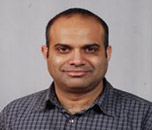
Jagmohan Dyal Singh
USA
Title: Neurobiological oriented treatment for amblyopia and amblyopia comorbid with refractive squint, diplopia, and headache
Biography
Biography: Jagmohan Dyal Singh
Abstract
Lazy Eye” syndrome or amblyopia is a common phenomenon scattered throughout the human population. It is estimated that around 5% of the human population suffers from this syndrome along with diplopia, and refractive squint present in many or rather most of the cases. It is quite possible that other animal species that depend on stereoscopic vision for their survival are also
prone to this condition in the same frequency as the human population. During prehistoric and ancient times, this condition did not interfere with human survival and this is the reason of its prevalence among the human population even in the present times. As it is present among 5% of the human population, it is no doubt a genetic condition. It has presented itself in individuals that have a genetic history of this condition in the maternal or paternal lineages. This condition is a major liability for the sufferer in the modern world. During ancient times, when man started as a hunter-gatherer and until the human world did not depend on the written word, this condition was a benign syndrome, possibly without any competitive disadvantage. That is the reason this condition has survived into the modern world. In the modern world, the major disadvantage is in field of academics. Children suffering from this condition are at a disadvantage due to their inability to study like other normal children. In the amblyopic patients, having diplopia and refractive squint near stereoscopic vision is disrupted during reading and other near vision activities. Two different images that are created in the visual cortices do not overlap. The glasses force the visual cortices to fuse the two different images into one which otherwise is impossible and makes amblyopia comorbid with refractive squint a difficult malady to correct with present treatment options. These glasses are based on the neurobiology of vision. How stereoscopic vision is processed by the brain and the understanding of underlying cause that produces this deficit in the brain of individuals afflicted with this disorder is also conceptualized in this
treatment option. Why 3D optics is helpful in correcting this disorder in the brain is also hypothesized in this paper. These glasses should only be used for near vision activities like reading through a book but not for reading through a computer screen or watching television, as no diplopia is present when words or visuals are seen on an illuminated background, although amblyopic patients who suffer headache while using a computer shall benefit immensely from this procedure. This method will correct the visual deficit and convergence insufficiency with 100% positive results and shall improve the academic capabilities of children suffering from amblyopia and refractive squint who complain of diplopia and headache while reading. These glasses will also correct the binocular acuity of individuals suffering from amblyopia. This can be done by breaking the suppression of visual signals sent by the amblyopic
eye to the brain. Prolonged use of these glasses will train the brain to make use of signals and images created in both the visual cortices into one. Hence, the brain will be forced to utilize visual signals from both the eyes due to its neurophysiology.
